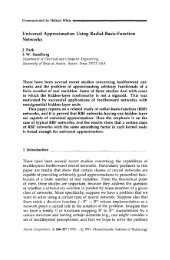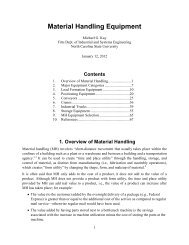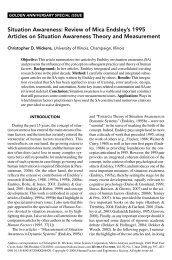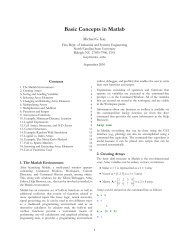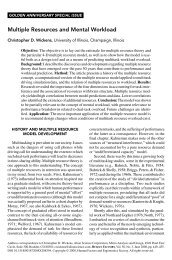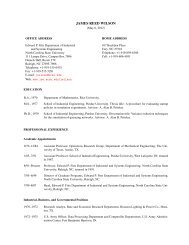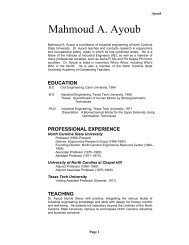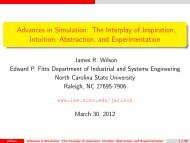Conventional Machining Methods for Rapid Prototyping
Conventional Machining Methods for Rapid Prototyping
Conventional Machining Methods for Rapid Prototyping
Create successful ePaper yourself
Turn your PDF publications into a flip-book with our unique Google optimized e-Paper software.
19<br />
<strong>Conventional</strong> <strong>Machining</strong> <strong>Methods</strong> <strong>for</strong> <strong>Rapid</strong> <strong>Prototyping</strong> and Direct<br />
Manufacturing<br />
6 Conclusion<br />
CNC-RP and WEDM-RP provide the possibility of using conventional processes,<br />
such as CNC milling and WEDM, as RM tools. One of the advantages <strong>for</strong> conventional<br />
subtractive process is their material processability. Additive processes have difficult in<br />
manufacturing full density part or parts with lattice structures. It will easier to subtract<br />
material from a block of material than to build lattice structures layer by layer. The better<br />
material processability also provides conventional subtractive processes better<br />
adaptability <strong>for</strong> new material.<br />
It is impossible to select one process as the single best solution <strong>for</strong> all RM<br />
applications. RM process selection can be based on the following criteria: geometric<br />
capability, accuracy, material flexibility, and manufacturing cost. The various RM<br />
processes vary dramatically in those criteria. Additive processes generally have good<br />
geometric capabilities, but are limited in material flexibility and accuracy. <strong>Conventional</strong><br />
subtractive processes are capable of manufacturing variety of materials with good<br />
accuracy, but limited in geometric capabilities. There<strong>for</strong>e, there is no unique answer <strong>for</strong><br />
RM process selection.<br />
With the systematic approaches provided by CNC-RP and WEDM-RP,<br />
engineering time is decreased substantially. These methods decrease the total engineering<br />
time by automatically generating process plans and decreasing human interaction. The<br />
unit cost range <strong>for</strong> CNC-RP decreases by an order of magnitude compared to<br />
conventional machining processes and is on the same order of magnitude as commercial<br />
additive RP processes. Furthermore, CNC and WEDM can provide higher accuracy<br />
products than normal additive rapid prototyping processes. These advantages make<br />
conventional processes competitive candidates <strong>for</strong> RM applications.<br />
7 Reference<br />
Bakkelund, J., R. Karlsen, et al. (1997) "Fabrication metal objects using layer<br />
manufacturing technology and powder metallurgy science", CIRP Annals -<br />
Manufacturing Technology, Vol.46, No. 1, pp.135-138.<br />
Bártolo, P. and B. Bidanda (2007) Bio-Materials and <strong>Prototyping</strong> Applications in<br />
Medicine, New York, Springer.<br />
Chen, Y. H. and Y. Song (2001) "The development of a layer based machining system",<br />
Computer-Aided Design, Vol.33, No. 4, pp.331-342.<br />
Dragomatz, D. and S. Mann (1997) "A classified bibliography of literature on NC milling<br />
path generation", CAD Computer Aided Design, Vol.29, No. 3, pp.239-247.<br />
Frank, M. C. (2003) "The development of a rapid prototyping process using computer<br />
numerical controlled machining", the Pennsylvania State University. Ph.D.<br />
dissertation: 146 leaves.<br />
Frank, M. C. (2003) "Subtractive <strong>Rapid</strong> <strong>Prototyping</strong>: Creating a Completely Automated<br />
Process <strong>for</strong> <strong>Rapid</strong> <strong>Machining</strong>". <strong>Rapid</strong> prototyping : principles and applications.<br />
C. K. Chua, K. F. Leong and C. S. Lim. Singapore ; New Jersey, World<br />
Scientific: 165-196.<br />
Frank, M. C. (2009) "The <strong>Rapid</strong> Manufacturing and <strong>Prototyping</strong> Laboratory (RMPL)."<br />
from http://www.ie.imse.iastate.edu/rmpl/default.aspx.<br />
Frank, M. C., R. A. Wysk, et al. (2004) "<strong>Rapid</strong> planning <strong>for</strong> CNC milling-A new<br />
approach <strong>for</strong> rapid prototyping", Journal of Manufacturing Systems, Vol.23, No.<br />
3, pp.242-255.<br />
Frank, M. C., R. A. Wysk, et al. (2006) "Determining setup orientations from the<br />
visibility of slice geometry <strong>for</strong> rapid computer numerically controlled



